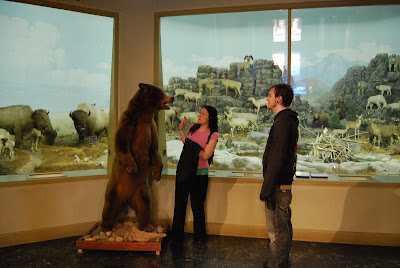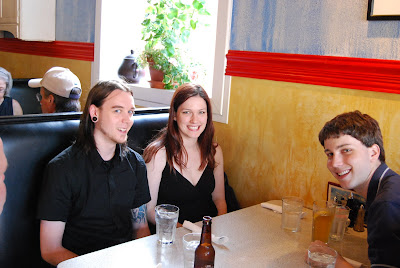 Here's my brother-in-law, Father (Lt. Col.) James Ludwikoski, second from left, in Kuwait in August 2007. He's with two others in the chaplain department, plus a firefighter (holding the boot). Jim is stationed in San Angelo, Texas, at the Air Force firefighting school. He retires in 2008 and is moving back to Kansas City.
Here's my brother-in-law, Father (Lt. Col.) James Ludwikoski, second from left, in Kuwait in August 2007. He's with two others in the chaplain department, plus a firefighter (holding the boot). Jim is stationed in San Angelo, Texas, at the Air Force firefighting school. He retires in 2008 and is moving back to Kansas City.
Wednesday, November 21, 2007
Jim in Kuwait
 Here's my brother-in-law, Father (Lt. Col.) James Ludwikoski, second from left, in Kuwait in August 2007. He's with two others in the chaplain department, plus a firefighter (holding the boot). Jim is stationed in San Angelo, Texas, at the Air Force firefighting school. He retires in 2008 and is moving back to Kansas City.
Here's my brother-in-law, Father (Lt. Col.) James Ludwikoski, second from left, in Kuwait in August 2007. He's with two others in the chaplain department, plus a firefighter (holding the boot). Jim is stationed in San Angelo, Texas, at the Air Force firefighting school. He retires in 2008 and is moving back to Kansas City.
Thursday, November 1, 2007
Friday, October 5, 2007
Wednesday, September 26, 2007
Saturday, September 15, 2007
Natural Trap Cave, Wyoming

In 1975, while working for the University of Kansas, I was assigned to report on a dig in a cave in Wyoming. I didn't know the Miocene from the Eocene, but I was happy to be on the road, it was a week out of the office, and I wanted to get back to Wyoming.
It was thrilling, from the drive up the rock-strewn single-lane John Blue Canyon (below was the carcass of a Range River that didn't survive) to the descent into the cave either by rope or on the rickety scaffolding.
I soon got a crash course in paleontology. For thousands of years during the Pleistocene Epoch, mammals had fallen into an 85-foot-deep cave on the western slope of the Big Horn Mountains. Paleontologists from KU and the University of Missouri at Columbia were digging up the bones of thousands of animals, such as mammoths, cheetahs, camels, bison, bears and horses.
 (Some of these bones are now on display at the KU's Dyche Museum of Natural History.)
(Some of these bones are now on display at the KU's Dyche Museum of Natural History.)I lived for a week in one of a score of army surplus tents at "Armpit Camp," about a mile from the cave and the site of an old uranium mining camp. It was hot, it was dry, it was fabulous. The food was great, the scenery and views were spectacular, the crew was entertaining, and the work was fascinating. We didn't even miss showers.
In the first photo, I may not look too interested (I'm the woman propping up her chin, eyes closed, on the right), but a small group of us had been up most of the night exploring caves by rappelling. Dropping in is easy, jumaring out is exhausting.
The second photo is of nearby Horseshoe Canyon, which is about 900 feet deep.
The third photo is of the grate over the mouth of Natural Trap Cave, installed to keep modern specimens from falling in.
The bottom photo is of expedition workers waiting at the camp for the Cornish Game Hens to grill.
I've been hooked on paleontology ever since this trip. I don't mean that I love the dirty work of actually uncovering bones and fossils and trying to figure out what and how old they are, but the excitement of seeing discoveries made in exotic locales and learning about how these animals lived and died. I'm afraid that makes me a bone-digging voyeur.
For more photographs and information about Natural Trap Cave, go to my other blog, http://www.kansascityobserver.blogspot.com/


Tuesday, September 11, 2007
Monday, September 10, 2007
Pineapple Project

Eat Local. It's fresher. It saves on transportation costs. It might even be cheaper. But what if your favorite fruit is pineapple, and you live in non-tropical Kansas City? Grow your own, says Ryan Harvey.

Twist off the leafy crown of a pineapple. If done successfully, you'll only leave a small divot in the pineapple and a small amount of flesh on the crown.
Hidden between the bottom layer of spiky leaves on the crown are small roots. Gently tear off the lower leaves until you reveal the roots. (See bottom photograph) The leaves will be flat and dry-looking. Let the crown dry for a few days, then set it in a glass of water so that only the root area is submerged. After a few more days, the roots should be plumped up and ready to plant in a pot of potting soil. Bring the pot indoors during the winter.
Watch this blog for progress. Eighteen months now, we should have a new pineapple. "The long wait makes you really appreciate pineapple," says Laura Ludwikosky.
Sunday, September 9, 2007
Beauty and the Beast


I saw this caterpillar chewing on my fennel plant yesterday (9-9-07). My first instinct was to kill it -- but just for an instant. I knew it was the larva of a black swallowtail butterfly.
Years ago, the first time I saw a caterpillar like this, I was horrified. And there wasn't just one, but seven caterpillars devouring my only parsley plant. It's not that I needed the parsley so much. (Actually, I didn't need it at all...) But I was repulsed. I clipped off what was left of the parsley stems -- the clinging caterpillars still obliviously eating -- and squashed all seven.
Later, when I was flipping through a gardening magazine, I saw this ugly creature again in a photograph next to the beautiful black swallowtail butterfly that it becomes. Remorse overcame my revulsion. I read once that newly hired gardeners at a butterfly garden in Georgia were busily ridding the plants there of pests, when the supervisor stopped them. You guessed it. They were killing the butterfly larvae.
Like a lot of people, I've never liked crawly things. It's hard to get over a natural repulsion. But it's doable. Sort of. I'll still smash any tomato horn worm I find.
I still don't love worms and caterpillars, but I'll rescue earthworms on the driveway after a rainstorm. And I'm looking out for the black swallowtail butterfly larva as it munches on my fennel, hoping a bird doesn't make a meal out of it. I can spare the fennel. I want to see butterflies in my yard next summer, like the one I photographed (see above) as it floated around the neighborhood this summer.
Later, when I was flipping through a gardening magazine, I saw this ugly creature again in a photograph next to the beautiful black swallowtail butterfly that it becomes. Remorse overcame my revulsion. I read once that newly hired gardeners at a butterfly garden in Georgia were busily ridding the plants there of pests, when the supervisor stopped them. You guessed it. They were killing the butterfly larvae.
Like a lot of people, I've never liked crawly things. It's hard to get over a natural repulsion. But it's doable. Sort of. I'll still smash any tomato horn worm I find.
I still don't love worms and caterpillars, but I'll rescue earthworms on the driveway after a rainstorm. And I'm looking out for the black swallowtail butterfly larva as it munches on my fennel, hoping a bird doesn't make a meal out of it. I can spare the fennel. I want to see butterflies in my yard next summer, like the one I photographed (see above) as it floated around the neighborhood this summer.
Subscribe to:
Comments (Atom)































